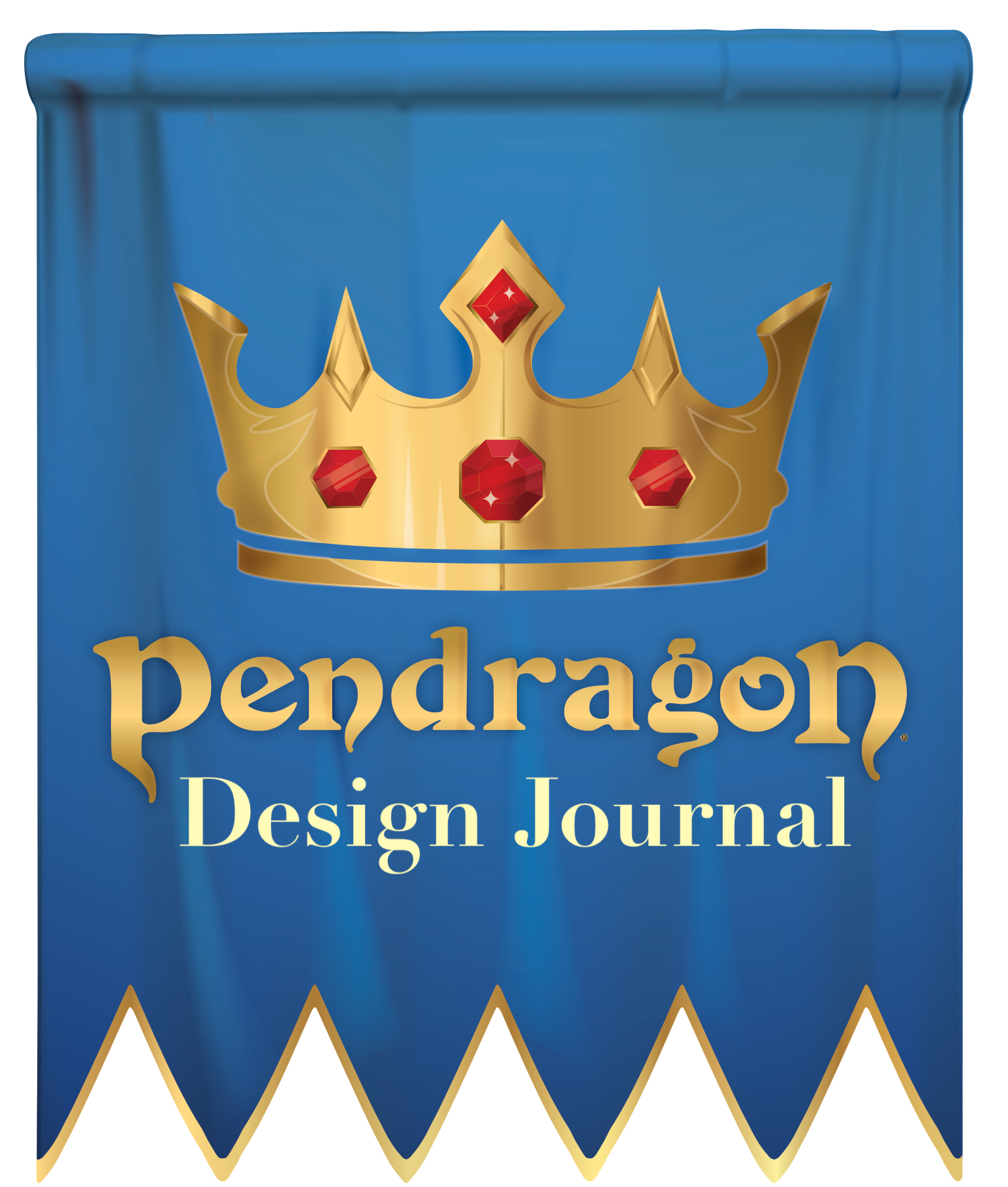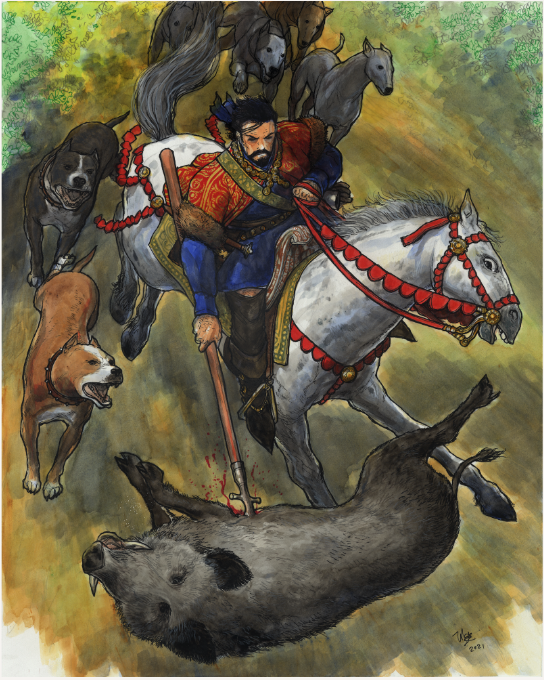Pendragon Design Journal #9: Of Horses and Squires
Posted by Michael O'Brien on 27th Apr 2022

By David Larkins, Pendragon line editor.
A new edition of the Pendragon RPG is coming! The intention of this series of design journals by Pendragon line editor David Larkins is to trace the path of development, starting in the early 1980s and culminating with the forthcoming new edition of the Pendragon RPG, which will be first to be wholly published by Chaosium in a quarter-century.
- Pendragon Design Journal #1: Where It All Began
- Pendragon Design Journal #2: Bringing the Light
- Pendragon Design Journal #3: A Modular Approach
- Pendragon Design Journal #4: Refining Traits and Passions
- Pendragon Design Journal #5: Honor and Glory
- Pendragon Design Journal #6: Combat!
- Pendragon Design Journal #7: The Social Game
- Pendragon Design Journal #8: The Battle System
It is a notable oddity of the English language that our word for “mounted noble warrior” has nothing to do with horses. Every other European word for knight derives from the horse, whether directly (chevalier, caballero) or by implication (Ritter). “Knight” refers instead to the social status of the person who holds the title, in its original meaning of “servant.” (Interesting to note that the word for another legendary mounted warrior, samurai, has a similar etymology, but I digress.)
Nevertheless, the knight’s bond with their horse is evident in related words such as chivalry and cavalier that share etymological roots with the Latin-derived words for “mounted warrior” found on the Continent.
The etymology of squire is much more straightforward: derived from esquire (from the Latin scutum), the word may be translated as “shield-bearer”—a clear reference to the squire’s role as helper and companion to their knight.
I remember when I first started playing Pendragon that one of the features of the game that immediately told me this was going to be a different sort of RPG experience was the inclusion of spaces on the character sheet for tracking your knight’s warhorse and squire.
Certainly, the idea of companion characters/animals under the control of a player is not unique to Pendragon, but what I found fascinating is that everyone got not just one but two such companions right from the start! Although both squire and horse serve important mechanical roles in the game – which remain unchanged in the new edition – these vital companions also provide the Player-knight with opportunities for roleplaying and characterization.
Past editions gave squires a bit more love than horses when it came to fleshing them out. In the new edition, rules for generating squires and their skill sets, introduced in 5th edition supplements, are now folded into the core rules.
Furthermore, the rules for making a Player-knight in 6th edition always initially result in a 14-year-old squire, giving groups the option to start play right away, with everyone as Player-squires, or else quickly age up their character until they qualify for knighthood around the age of 21. There is therefore the option to create an even more fully fleshed-out squire using the basic character creation rules.

But what of horses?
Here, 6th edition finally gives these noble beasts their due, including an entire chapter all their own in the core rulebook. Here we find tables and descriptions for all the mounts of the Boy King Period, along with their armor. Terminology for horse breeds and tack is covered, along with the significant mechanical differences between Combat and Non-Combat Trained Horses.
It is in the second half of the chapter that we are treated to a few simple rules that, taken together, really elevate the horse from a mere mode of transportation and weapon of war to a true companion, with their own unique presence.
First comes the choice of whether or not to ride a stallion: stallions require increased maintenance and training, and are harder to control than mares or geldings. The payoff is a bit of Passive Glory earned every year in recognition of your character’s superior Horsemanship, for that is what it takes to ride one into battle without handicap.
Then comes the question of coat and markings. Picking out the right sort (or having it gifted to you) is vital to every status-conscious knight. The most expensive color is gray, followed by bay, yellow, chestnut, and dun, with black as the least expensive. Pale horses are rare enough to seldom be available, but may be gifted by fairies. True white horses are so rare as to never be available for purchase, being bestowed instead as significant gifts or rewards.
White, gray, and bay warhorses grant a bit of Passive Glory so long as they are the knight’s primary steed; a knight who rides a white stallion receives 30 Passive Glory every year!
But what of that steed’s personality? Provided is an optional table where, with one or more rolls of a D20, you can quickly generate your horse’s quirks that render the creature instantly memorable. In my current campaign, one of my Player-knights has a Charger with the “Chowhound” trait, meaning it takes any opportunity to grab a bite to eat, even when inappropriate. The horse is affectionately named Mouth, and has seen his master through many a bloody battle and strange quest; his master, in turn, lavishes him with care and attention, even though he is by no means a rich knight, in an effort to keep the cold hand of the annual Horse Survival roll at bay.
I have personally witnessed excited Players happily blow their treasuries on the best breed of horse they can afford, and use all their leftover denarii on draping their precious steed in the best armor available. (This didn’t prevent another Player-knight’s horse from being swallowed whole by a terrible serpent, but the less said about that, the better.)
These rules do not apply just to warhorses, of course, and knights and ladies alike may delight in finely-bred amblers for their cross-country rides, or coursers specially bred for the hunt.
If you good folk are anything like nearly every group I’ve ever run Pendragon for, there are at least some among you who even now are contemplating the possibilities of maximizing Glory and cutting out the costly middleman by having your character embark upon a horse-breeding program of their own. And for that, you need look no further than the system which appears in the appendices of the Noble’s Guide, which presents a simple system for determining the offspring of dedicated breeding programs.
With the right resources, and a little luck, your Player-knight or lady may thus produce from amongst their herd a horse of truly outstanding quality. Best of luck, and may Epona look kindly upon your efforts!
Art: 'Boar Hunt' by Mark Smylie.
